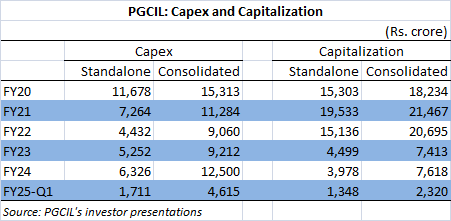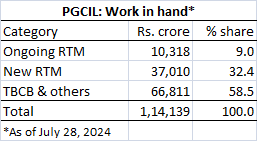Power Grid Corporation of India Ltd (PGCIL) has upwardly revised its capital expenditure (capex) target for FY25, which now stands at Rs.18,000 crore as against Rs.15,000 crore previously indicated.
R.K. Tyagi, CMD, PGCIL, whilst addressing a recent investor conference, said that company would be undertaking capex of Rs.18,000 crore in the ongoing fiscal year FY25. This capex will be on consolidated basis, which is to say, it will include both TBCB projects as well as RTM projects.

If this planned target materializes, it will be the highest capex undertaken by PGCIL in any fiscal year, since FY20 at least. (See table).
PGCIL’s “official” capex target for FY25, as envisaged by the plan outlay in the Union Budget: 2024, stands at Rs.12,500 crore.
In Q1FY25, PGCIL’s capex was Rs.4,615 crore, at the consolidated level. In this period, capitalization stood at Rs.2,320 crore out of which a larger part, at Rs.1,348 crore, represented RTM projects while the remaining Rs.972 crore came from TBCB projects. [Capitalization broadly means the value of projects that have been commissioned and hence turned into commercial assets.]
In physical terms, PGCIL commissioned 91 ckm of transmission lines and 1,315 MVA of substation capacity in Q1FY25 – coming from both RTM and TBCB assets.
Work-in-hand
 As of July 26, 2024, PGCIL had Rs.1,14,139 crore worth of work in hand. This included Rs.10,318 crore worth of ongoing RTM projects and Rs.37,010 crore on new RTM projects. Significantly, the maximum share was of “Other projects” that includes TBCB power transmission projects, smart metering, data centre projects, etc. This category accounted for 58.5 per cent (Rs.66,811 crore in value terms) of the total work-in-hand. (See table)
As of July 26, 2024, PGCIL had Rs.1,14,139 crore worth of work in hand. This included Rs.10,318 crore worth of ongoing RTM projects and Rs.37,010 crore on new RTM projects. Significantly, the maximum share was of “Other projects” that includes TBCB power transmission projects, smart metering, data centre projects, etc. This category accounted for 58.5 per cent (Rs.66,811 crore in value terms) of the total work-in-hand. (See table)
It may be mentioned that new RTM projects predominantly include the Leh HVDC project and the HVDC-based evacuation infrastructure associated with proposed offshore wind farms in Gujarat and Tamil Nadu.
Business opportunity
Between now and 2032, PGCIL estimates a business opportunity size of Rs.2,07,500 crore that includes Rs.1,90,500 crore in the power transmission business, and the remaining Rs.17,000 crore in other areas like solar power generation, smart metering and data centres. Within the power transmission business opportunity basket, little of over 70 per cent is seen coming from interstate lines that PGCIL develops through both the TBCB and RTM routes. The residue is spread over intrastate lines, cross-border lines and international projects.
New initiatives
Speaking of new technology initiatives, R.K. Tyagi mentioned that PGCIL has entered into an MoU with Indian Space Research Organisation (ISRO) to create a “Spatial Decision Support System” for remote management of transmission towers. This system will feature a geospatial dashboard and tools for disaster analysis and vegetation monitoring along transmission corridors. This system will be particularly helpful in monitoring transmission towers situated in challenging topography like on hills and along riversides.
 Besides, PGCIL, in association with IIT-Kanpur, has developed a substation inspection robot on which field trials were successfully carried out at PGCIL’s Kanpur substation, recently (see photograph). This robot uses Artificial Intelligence (AI) and Machine Learning (ML) during inspection of substations and is expected to help in efficiency improvement in transmission system operations, Tyagi explained. PGCIL will deploy such inspection robots at other substations in future, the CMD added.
Besides, PGCIL, in association with IIT-Kanpur, has developed a substation inspection robot on which field trials were successfully carried out at PGCIL’s Kanpur substation, recently (see photograph). This robot uses Artificial Intelligence (AI) and Machine Learning (ML) during inspection of substations and is expected to help in efficiency improvement in transmission system operations, Tyagi explained. PGCIL will deploy such inspection robots at other substations in future, the CMD added.
Also read: PGCIL emerges L1 for mega HVDC scheme in Rajasthan



